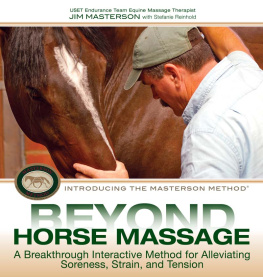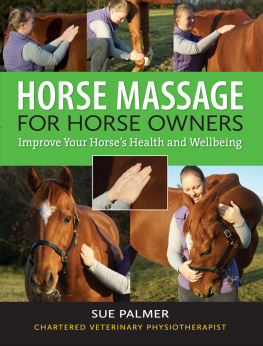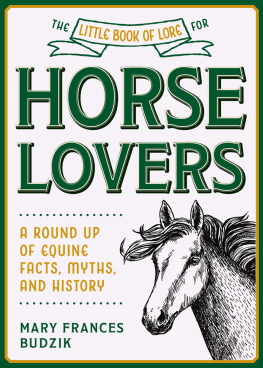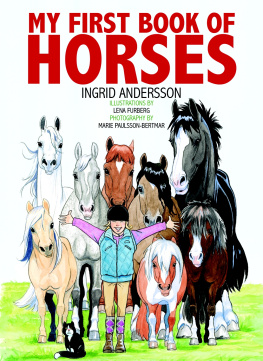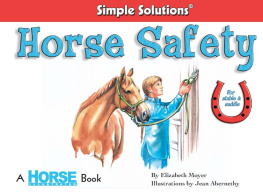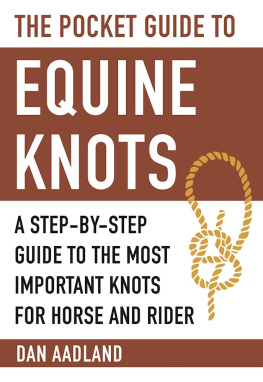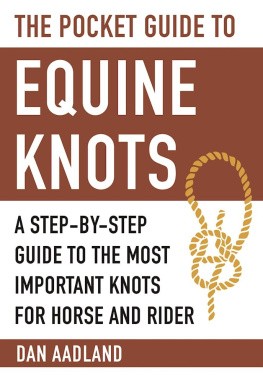First published in 2011 by
Trafalgar Square Books
North Pomfret, Vermont 05053
Printed in China
Copyright 2011 Jim Masterson
All rights reserved. No part of this book may be reproduced, by any means, without written permission of the publisher, except by a reviewer quoting brief excerpts for a review in a magazine, newspaper, or Web site.
Disclaimer of Liability
The authors and publisher shall have neither liability nor responsibility to any person or entity with respect to any loss or damage caused or alleged to be caused directly or indirectly by the information contained in this book. While the book is as accurate as the authors can make it, there may be errors, omissions, and inaccuracies.
Library of Congress Cataloging-in-Publication Data
Masterson, Jim.
Beyond horse massage : a breakthrough interactive method for alleviating soreness, stress, and tension / Jim Masterson with Stefanie Reinhold ; foreword by McLain Ward
p. cm.
Includes bibliographical references and index.
ISBN 978-1-57076-472-1 (hardcover)
1. HorsesDiseasesAlternative treatmentHandbooks, manuals, etc. 2. Massage for animalsHandbooks, manuals, etc. 3. Veterinary physical therapyHandbooks, manuals, etc. 4. HorsesHealthHandbooks, manuals, etc. 5. HorsesEffect of stress onHandbooks, manuals, etc. 6. Stress (Physiology)Handbooks, manuals, etc. 7. Stress managementHandbooks, manuals, etc. I. Reinhold, Stefanie. II. Title.
SF951.M425 2011
636.1089--dc23
2011030823
The photograph on is by Lori McIntosh Photography.
All other photographs by Marcus Brauer ( (Leona Reinhold).
Illustrations from: The Horses Back in Motion by Sarah Wyche and used by permission of the publisher (pp. 64 top, 105 bottom, 106, 107, 108, 109, 110, 152); Tug of War: Classical versus Modern Dressage by Dr. Gerd Heuschmann and used by permission of the publisher (pp. 35, 64 bottom).
Book design by Lauryl Eddlemon
Cover design by RM Didier
Typeface: Myriad
10 9 8 7 6 5 4 3 2 1
This, my first book, is dedicated to
my parents, who by their approach to life taught me how to live outside the box,
my partner and wife Conley, who keeps me going,
and of course to, The Horse, whatever else can be said about it.
Contents
Foreword
I first met Jim Masterson at the 2006 World Equestrian Games in Aachen, Germany. Sometimes it can be stressful to have new people working on your horse the last two weeks before a big event, but Jim has such a relaxed demeanor around horses (and riders) that all the US Endurance Team members were actually vying for his time. The horses clearly love Jims techniques, and the result is better range of motion with a reduced risk of injury. (An added benefit is that watching him work on a horse actually relaxes the observer, too!)
Unfortunately Jim and I live in different parts of the country so I do not get to see him nearly enough, but I have had the great fortune to work with him at all the world championships since that first time in Germanyand at several other major rides in between. Jim is always a huge asset, both because of his skills in massage and his willingness to jump in and help in any way he can. He is the epitome of team player, andas youll find in his bookhis sense of humor is fabulous!
Beyond Horse Massage offers the reader a window into Jims work and allows clear access to his unique body of knowledge. With this book, Jim has given us the tools to support our horses in ways most of us could previously only imagine. He has empowered us to maximize performance by improving flexibility. The end result is reduced susceptibility to injuries, as well as heightened performance. But his methods can be used for other purposes, as well. His bodywork is a powerful tool for speeding recovery after strenuous workouts, and its use significantly reinforces the riders/trainers relationship with the horse.
Meg Sleeper, VMD, DACVIM (Cardiology) Member United States Endurance Squad 2004, 2006, 2008, 2010
Preface
W hen I first began working with competition horses I was hauling and grooming horses for a show barn on the A-level hunter-jumper circuit in the Midwest. Before this, I had never had an interest in massage or physical therapy of any kindhuman or animal.
This all changed while at a spring horse show in Estes Park, Colorado. Our trainer hired two equine massage therapists to work on our horses. They started their massage by going very gently with their hands over an area of the horse called the bladder meridian. This exercise was to relax the horse before the actual muscle work began. I was fascinated by the subtle responses in the horses eyes, lips, and breathing as they slowly ran their hands lightly over him. Although the horse was certainly relaxed by the time they were done, I noticed that there was a definite correlation between where their hands were on the horse, the changes in the horses eyes (for example), and other subtle responses of the horse during this process.
I suggested to the trainer that she hire these two wonderful and very sensitive massage therapists to spend a few hours teaching me some basics of equine massage that I could use on our barns horses, at the shows and at home. Having virtually no other training in massage, to guide my work I relied mainly on paying attention to what the horse was telling me through his subtle responses. Fascinated by the reaction to very light input, I applied very subtle levels of touch, waiting to see what would happen. I found that I could get a response from the horse with almost no contact at all. By being patient (lazy), watching what was going on with the horse, and adjusting the levels of pressure (or no pressure), I found that the horse would give larger and larger visual responses that correlated with softening and releases of tension in the areas I was working on.

As my goal was to improve movement and mobility more than to work with the muscle itself, I began to apply movement to this method of releasing tension in the horse. I found that by staying under the horses threshold of bracing and resistance, I could find restriction and then ask for movement in a way that allowed the horse to release the tension in an area. He would then let me know he had released the tension with large release responses, such as repeated yawning, snorting, and sneezing, and rolling back the second eyelid. This interaction with the horse turned out to be not only fun, but effective.
I also had the benefit of working in the highly competitive environment of show jumping. I was fortunate to have access to valuable feedback from talented trainers, riders, veterinarians, and equine therapistsnot to mention the horses. With this feedback, I was able to determine what specific areas of the horse consistently accumulated tension in work, which when released, showed improvement in performance.
As I gained more clients, the interactive, intuitive, and results-oriented nature of this bodywork began to attract the attention of horse owners interested not only in performance but in relationship, communication, and the bond of trust that develops with the horse. The results could actually be seen as the work was being done on the horse. I began showing interested owners what to look for, and how to apply basic techniques. This soon led to the making of an instructional DVD, Equine Massage for Performance Horses: The Masterson Method, then to demonstrations for riding clubs and barns. In 2005 I began teaching Weekend Seminar Workshops around the country and began getting requests from people in Europe and Australia who had bought the DVD from our website.
Next page
